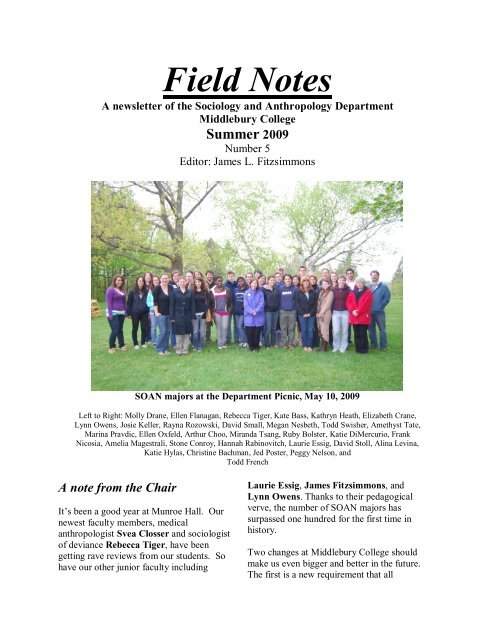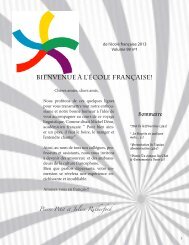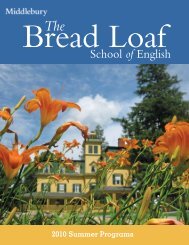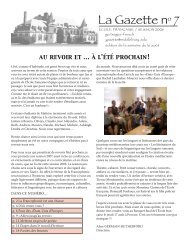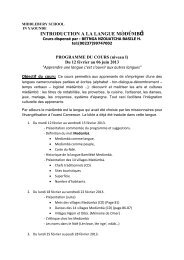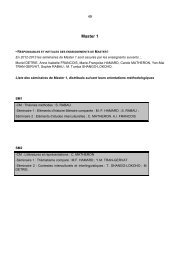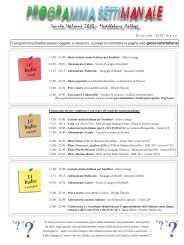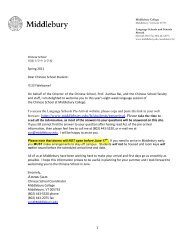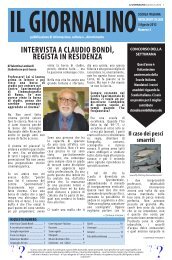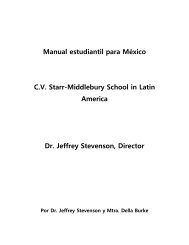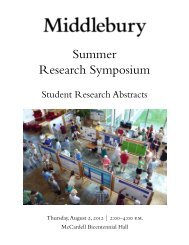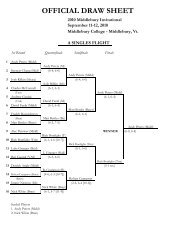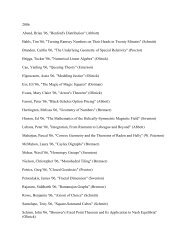2009 - Middlebury College
2009 - Middlebury College
2009 - Middlebury College
You also want an ePaper? Increase the reach of your titles
YUMPU automatically turns print PDFs into web optimized ePapers that Google loves.
Field Notes<br />
A newsletter of the Sociology and Anthropology Department<br />
<strong>Middlebury</strong> <strong>College</strong><br />
Summer <strong>2009</strong><br />
Number 5<br />
Editor: James L. Fitzsimmons<br />
SOAN majors at the Department Picnic, May 10, <strong>2009</strong><br />
Left to Right: Molly Drane, Ellen Flanagan, Rebecca Tiger, Kate Bass, Kathryn Heath, Elizabeth Crane,<br />
Lynn Owens, Josie Keller, Rayna Rozowski, David Small, Megan Nesbeth, Todd Swisher, Amethyst Tate,<br />
Marina Pravdic, Ellen Oxfeld, Arthur Choo, Miranda Tsang, Ruby Bolster, Katie DiMercurio, Frank<br />
Nicosia, Amelia Magestrali, Stone Conroy, Hannah Rabinovitch, Laurie Essig, David Stoll, Alina Levina,<br />
Katie Hylas, Christine Bachman, Jed Poster, Peggy Nelson, and<br />
Todd French<br />
A note from the Chair<br />
It’s been a good year at Munroe Hall. Our<br />
newest faculty members, medical<br />
anthropologist Svea Closser and sociologist<br />
of deviance Rebecca Tiger, have been<br />
getting rave reviews from our students. So<br />
have our other junior faculty including<br />
Laurie Essig, James Fitzsimmons, and<br />
Lynn Owens. Thanks to their pedagogical<br />
verve, the number of SOAN majors has<br />
surpassed one hundred for the first time in<br />
history.<br />
Two changes at <strong>Middlebury</strong> <strong>College</strong> should<br />
make us even bigger and better in the future.<br />
The first is a new requirement that all
seniors will do senior projects. This is<br />
nothing new for SOAN, but it has made us<br />
think how we can improve our senior<br />
process. Henceforth students who earn an<br />
A- or A for their single-semester projects<br />
will earn Honors and students who do longer<br />
projects will be able to work on them for<br />
two regular semesters plus Winter Term, not<br />
just fall or spring semester plus Winter<br />
Term.<br />
The second change is the college’s plan to<br />
reduce class size. This will mean capping<br />
enrollment in our courses at 45 students, not<br />
the current 60, which requires us hire a sixth<br />
anthropologist and a sixth<br />
sociologist. We’ve already been able to<br />
hire our sixth sociologist, Chong-suk Han,<br />
who has been teaching at Temple University<br />
in Philadelphia and will join us in<br />
September <strong>2009</strong>.<br />
Chong-suk Han’s scholarly interests focus<br />
on the sociology of race and gender. He is<br />
interested in examining the social factors<br />
that help to maintain racial, gendered, and<br />
sexual inequalities and how these<br />
inequalities impact the lives of racial and<br />
sexual minorities from a social<br />
psychological perspective. Chong-suk<br />
received his Ph.D. in 2007 from the<br />
University of Washington, where he wrote a<br />
dissertation entitled Geisha of a Different<br />
Kind: Negotiating Gay Asian Male<br />
Identitites. He has taught at Temple<br />
University since 2005. This coming year,<br />
Chong-suk will be teaching Society and the<br />
Individual with Lynn Owens, as well as<br />
Social Psychology in Sociology, The<br />
Continuing Significance of Race in the<br />
United States, and Politics of Identity.<br />
In April, our department co-sponsored a<br />
conference on race, gender and the<br />
economy. The conference, Racing<br />
Capitalism/Sexing Money: A Conference<br />
on Race, Gender and the Economy was the<br />
result of collaboration between the college's<br />
newly formed Center for the Comparative<br />
Study of Race and Ethicity (CCSRE) and<br />
the Gensler Symposium of the Women and<br />
Gender Studies Program. The conference<br />
brought together scholars from a variety of<br />
fields (economics, sociology, anthropology,<br />
geography) to discuss how global capital is<br />
shaped by and shapes gender and race.<br />
The keynote speakers were geographer<br />
David Harvey and anthropologist Jane<br />
Collins. Harvey gave a broad historical<br />
view of the inevitable crisis in global<br />
capitalism while Jane Collins located that<br />
crisis in her research on the brown and<br />
female bodies of temporary workers in the<br />
hospitality industry. The next day, a variety<br />
of issues were explored. Economist<br />
Stephanie Seguino discussed how economic<br />
collapse is, historically speaking, worse for<br />
women and children while Jose Garcia, an<br />
economist from Demos Institute showed<br />
how and why the subprime mortgage crisis<br />
was located in neighborhoods that were<br />
primarily Black and Latino. I myself spoke<br />
on the financialization of the indigenous<br />
peoples with whom I work and Laurie<br />
Essig explained the current economic crisis<br />
through cosmetic surgery. The result was<br />
what one participant called "the most<br />
intellectually stimulating conference I have<br />
ever been to."<br />
The hiring of our sixth anthropologist is on<br />
hold at the moment, because of the college’s<br />
fiscal situation. When approval comes,<br />
we’ve agreed to recruit a linguistic<br />
anthropologist. Ever since Prof. Mark<br />
Southern streaked across our firmament in<br />
2004-06, dozens of students in SOAN and<br />
the language departments have clamored for<br />
independent majors and/or a minor in<br />
linguistics. The minor should come together<br />
in <strong>2009</strong>-10 thanks to half a dozen language
profs with whom SOAN is enthusiastically<br />
collaborating. Best of all, a linguistic<br />
anthropologist will enable another historic<br />
first for <strong>Middlebury</strong> <strong>College</strong>—4-field<br />
anthropology with courses every year in, not<br />
just our mainstay of sociocultural<br />
anthropology, but also archaeology, physical<br />
anthropology and linguistics.<br />
David Stoll<br />
SOAN Chair, 2008-<strong>2009</strong><br />
Faculty and Staff Updates<br />
Charlene Barrett<br />
We had another great academic year in the<br />
Sociology/Anthropology Department. I'm<br />
looking forward to another one, in which I'm<br />
already preparing for. As always, I’m<br />
looking forward to the warm summer<br />
months, the sunshine, and spending more<br />
time with my family!<br />
Svea Closser<br />
I’ve really enjoyed getting to know<br />
<strong>Middlebury</strong> this year. My students are great,<br />
and Vermont is a nice change from Atlanta.<br />
My three-year-old son and I have already<br />
accumulated six pairs of skis. I’m currently<br />
finishing up a book on polio eradication in<br />
Pakistan that will be published by<br />
Vanderbilt University Press this year. (I<br />
need a good title—so if you have any<br />
suggestions, let me know.) I’m also working<br />
with some students and other faculty on<br />
developing an interdisciplinary series of<br />
courses on global public health at<br />
<strong>Middlebury</strong>.<br />
Laurie Essig<br />
This year I was lucky to be involved in a<br />
variety of new and exciting projects and<br />
programs at <strong>Middlebury</strong>. I continued to sit<br />
on the steering committee for the newly<br />
formed Center for the Comparative Study of<br />
Race and Ethnicity (CCSRE) as well as<br />
Women and Gender Studies and the newly<br />
formed Queer Studies House (QSH). I was<br />
lucky enough to bring my interest in gender,<br />
sexuality, and race together in a variety of<br />
ways. For instance, in the fall the QSH and<br />
CCSRE brought Kenyon Farrow to campus<br />
to discuss disco as both a gay and a Black<br />
cultural phenomenon. In the Spring, I was<br />
able to combine my role in organizing the<br />
Gensler Symposium for women's studies<br />
and gender with CCSRE to help organize a<br />
conference on race, gender and the<br />
economy. The conference brought together<br />
a variety of scholars and activists to discuss<br />
how global capitalism plays out differently<br />
on different bodies. I myself got to explain<br />
the credit crisis through cosmetic surgery.<br />
Which brings me to my book, American<br />
Plastic: Boob Jobs, Credit Cards and the<br />
Spirit of Our Time, which will be published<br />
by Beacon in 2010. Fortunately I am on<br />
sabbatical this coming year so I can get it<br />
done. As part of sabbatical, my girls and I<br />
will be living in Montreal in the Fall and<br />
then London in the Spring and generally<br />
having an adventure.<br />
All the while I am<br />
hoping that I'll<br />
continue to have<br />
my gig as a blogger<br />
at<br />
www.trueslant.com<br />
/laurieessig if<br />
anyone wants to<br />
know what I'm<br />
thinking.<br />
James L. Fitzsimmons<br />
It’s been a busy year. My book, Death and<br />
the Classic Maya Kings, was published by<br />
the University of Texas Press in <strong>2009</strong>. I also<br />
published a co-authored encyclopedia on<br />
peoples of the Americas, titled The<br />
Greenwood Encyclopedia of Global
Medieval Life and Culture, Vol. 1: Europe<br />
and the Americas. An edited volume I did<br />
with Izumi Shimada, an Andean<br />
archaeologist, was accepted for publication<br />
by the University of Arizona Press and has<br />
been sent to them for copyediting; it is titled<br />
Between the Living and the Dead in Ancient<br />
Mesoamerica. In the Spring semester, I was<br />
invited to chair an October <strong>2009</strong> conference<br />
on Maya political organization at<br />
Dumbarton Oaks, in Washington, D.C. I’m<br />
really looking forward to it!<br />
Perhaps most notably, though, the<br />
archaeology lab was finally built in Munroe<br />
111, and I have been busy filling it with<br />
equipment and materials over the past few<br />
months. We now have computers, scanners,<br />
drawing tables, and all kinds of<br />
excavation/lab equipment in there, in<br />
addition to the usual complement of bones<br />
and stones. This summer I will be working<br />
in there on material from my field site,<br />
Zapote Bobal, and getting the lab ready for<br />
classes in the fall; I will also be plugging<br />
away at papers (mostly for a companion to<br />
the Mesoamerican edited volume on the<br />
Andes) and particularly grants, as I will be<br />
going on leave in 2010-2011.<br />
Peggy Nelson<br />
I have been happily<br />
back from leave this<br />
year, enjoying being in<br />
the classroom again. I<br />
have also completed a<br />
co-edited book, Who's<br />
Watching? Daily<br />
Practices of<br />
Surveillance Among<br />
Contemporary<br />
Families and, with little<br />
success, have been trying to complete my<br />
manuscript, Parenting Out of Control: Child<br />
Rearing Among the Professional Middle<br />
Class. This summer, once the book is done,<br />
I plan to take some leisurely vacation time<br />
with family and friends.<br />
Lynn Owens<br />
I kicked off the fall semester with an<br />
elaborate flourish – while doing research at<br />
the Republican National Convention in St.<br />
Paul, MN, I found myself, along with<br />
hundreds of others, on the wrong side of the<br />
law. Luckily, I only suffered the<br />
inconvenience of a night in jail before<br />
having all my charges eventually dropped.<br />
Others, such as the organizers of the protest,<br />
were not so fortunate.<br />
Wriggling<br />
free of my<br />
police<br />
captors<br />
was not<br />
my only<br />
accomplishment this year; I also managed to<br />
have two books published. The first came<br />
out in the fall, a co-authored cookbook,<br />
featuring the favorite recipes of bands, of the<br />
obscure and even more obscure variety. The<br />
book, Lost in the Supermarket: An Indie<br />
Rock Cookbook, published by Soft Skull<br />
Press, allowed me to make the PR rounds,<br />
where I learned I like talking to music<br />
reporters a lot more than food reporters. My<br />
other book, Cracking under Pressure:<br />
Narrating the Decline of the Amsterdam<br />
Squatters’ Movement, joint published by<br />
Amsterdam University and Penn State<br />
University Presses, comes out of my<br />
dissertation research. The work follows the<br />
rise and fall of the squatters’ movement in<br />
Amsterdam during the 1970s and 80s,<br />
focusing on how activists used stories to<br />
construct new identities and strategies in the<br />
face of new constraints and setbacks. During<br />
J-Term, I managed to sneak away to Madrid,<br />
to meet with others researching European
squatters’ movements, as we planned a<br />
larger trans-European research network and<br />
comparative project. And perhaps my<br />
biggest triumph of the year: I got a new cat,<br />
Gretl, to join the other two in the household,<br />
Candyflip and The Skunk.<br />
Ellen Oxfeld<br />
I submitted the final draft of my book to the<br />
publisher (University of California Press) in<br />
April. The book now goes into<br />
the production phase. I hope these last<br />
details (copyediting, reading proofs and<br />
creating an index) will be complete within<br />
the next few months! If all goes well, the<br />
book will be out in 2010 (When You Drink<br />
Water, Remember the Source: Moral<br />
Discourse in a Chinese Village). This<br />
summer, I will be traveling to a conference<br />
in Taiwan for East Asian anthropologists<br />
and presenting a paper on food as embodied<br />
memory in post-Mao rural China. It's part<br />
of a larger project on the culture of food in<br />
rural China.<br />
Burke Rochford<br />
This past Winter Term, I spent two weeks<br />
teaching in Belgium at Bhaktivedanta<br />
<strong>College</strong>, a small college for members of the<br />
Hare Krishna movement. My course<br />
focused on the<br />
development of<br />
religious<br />
movements incl<br />
uding the Hare<br />
Krishna. This<br />
spring my<br />
article,<br />
"Succession, Religious Switching, and<br />
Schism in the Hare Krishna<br />
movement," appeared in Sacred Schisms,<br />
edited by James Lewis and Sarah Lewis,<br />
published by Cambridge University Press.<br />
Michael Sheridan<br />
I have been on sabbatical this year, and I<br />
recommend it highly. This spring I have<br />
been a Visiting Scholar in Human Ecology<br />
at Lund University in<br />
Sweden. I have<br />
given a series of<br />
lectures on ‘Ecology<br />
and Power’ in Lund<br />
and Stockholm.<br />
Lund is very much a<br />
medieval town<br />
wrapped inside of a<br />
university city, and<br />
my kids have learned<br />
more than they know<br />
from being in such a vibrant place for 5<br />
months. My next destination is Senegal,<br />
where I will be participating in a faculty<br />
seminar supported by a Fulbright grant for<br />
the month of July <strong>2009</strong>. The overall goal is<br />
to enhance the West African content of<br />
SOAN 332, and I will also be able to do an<br />
independent fieldwork project on<br />
ethnobotany and property rights in Senegal’s<br />
southern forests.<br />
David Stoll<br />
I continue going to Guatemala every chance<br />
I get, to talk with the Ixil Mayas of Nebaj<br />
about their credit crisis. Having outstripped<br />
their very limited agricultural base,<br />
thousands of Ixils have borrowed money to<br />
invest in $5,000 trips to the United States,<br />
where many fail to find enough work to pay<br />
off the loans. Since I reported on this<br />
situation in the 2008 newsletter, financial<br />
institutions have started to foreclose on<br />
houses and a new women’s committee is<br />
asking aid organizations to pay their debts.<br />
Not coincidentally, I will be teaching a new<br />
course on Latin American migration in Fall<br />
<strong>2009</strong>. One of the questions we’ll be looking
at is whether migration of this sort operates<br />
like a pyramid scheme, in which migrants<br />
attempt to pay off their deficits by<br />
convincing peers to pay for a trip north, thus<br />
widening the circle of indebtedness.<br />
It took ten years to find<br />
a publisher for the<br />
Spanish version of<br />
Rigoberta Menchú and<br />
the Story of All Poor<br />
Guatemalans but it’s<br />
finally available, with a<br />
big thank-you to Unión<br />
Editorial of<br />
Madrid. Thanks as<br />
well to Westview Press<br />
for publishing a new<br />
edition of the 1999 English version. The<br />
new edition has a foreword by Elizabeth<br />
Burgos, the anthropologist who elicited and<br />
published Rigoberta’s 1982 life story, and<br />
my own aferword, which includes<br />
Rigoberta’s efforts to indict Guatemalan<br />
generals for genocide and also her campaign<br />
to be elected president of her country.<br />
Rebecca Tiger<br />
Having finished my PhD and moved to<br />
Vermont, I spent<br />
this past year<br />
learning about life at<br />
<strong>Middlebury</strong> <strong>College</strong>.<br />
I taught courses on<br />
punishment,<br />
deviance and social<br />
control, drugs and<br />
introductory social<br />
theory – I’m looking<br />
forward to teaching<br />
these courses again next year. An article I<br />
co-authored with Barbara Katz Rothman,<br />
my advisor from the CUNY Graduate<br />
Center, was published in Fall 2008 in the<br />
Journal of Clinical Issues. In this<br />
publication we argue against medical control<br />
of child abuse and neglect cases and for an<br />
expansion of non-punitive social services for<br />
families experiencing multiple economic<br />
and social stressors. After a vacation in<br />
Slovenia, Croatia and Montenegro, where I<br />
plan on reading fiction and swimming in the<br />
Adriatic Sea, I will be spending this summer<br />
working on two projects. First, I am<br />
revising my dissertation into a book<br />
manuscript, tentatively titled “Force is the<br />
Best Medicine”: The Logic of Coerced<br />
Treatment, in which I examine historically<br />
and theoretically the rise of coerced drug<br />
treatment as strategy for controlling drug<br />
users in the criminal justice system, and<br />
suggest policy alternatives that remove drug<br />
users from coerced punitive and therapeutic<br />
oversight. Secondly, I am beginning a new<br />
project looking at the social control of<br />
young people in the criminal justice system,<br />
specifically investigating how designations<br />
such as “delinquent” and “at-risk youth”<br />
give rise to long-lasting forms of<br />
institutional control and surveillance for the<br />
young people so designated. I look forward<br />
to returning to <strong>Middlebury</strong> in September and<br />
to (finally) learning how to snow board this<br />
upcoming winter.<br />
Senior Essay and Thesis<br />
Abstracts<br />
Christine Bachman<br />
“Grabbing Madonna’s Crotch: Queering<br />
Gender, Sexuality, Race, Class and Age”<br />
Humping the Radio City Music Hall stage in<br />
a wedding dress in 1984, grabbing her<br />
crotch in a pinstripe suit in 1989, offering<br />
her open crotch to sexual “deviants” in 1995,<br />
and shoving her hands down her pants in<br />
2008, Madonna has thrust herself—and her<br />
crotch—into the mainstream music market<br />
for twenty-five years. What is the
significance of Madonna’s hyper-visible<br />
crotch? My primary interest in Madonna<br />
revolves around her “crotch grab,” or in<br />
other words, her use of the Phallus and<br />
phallic power. In order to explore the<br />
importance of the crotch grab, I have<br />
conducted a content<br />
analysis of several of<br />
Madonna’s most<br />
significant music<br />
videos, live<br />
performances and<br />
tours throughout the<br />
past two and a half<br />
decades. In these<br />
performances, the<br />
crotch grab becomes an important<br />
intersection of meaning, as Madonna uses<br />
gender, sexuality, race, class and age to<br />
communicate an ever-changing message to<br />
the audience. To think through the<br />
significance of the crotch grab, I draw<br />
primarily on the theories of Judith Butler,<br />
Judith Halberstam, Pierre Bourdieu, Anne<br />
McClintock, Lee Edelman, Michel Foucault,<br />
and Donna Haraway. In my analysis of<br />
Madonna’s crotch grab, I seek to discover<br />
whether or not Madonna queers gender,<br />
sexuality, race, class and age.<br />
Kara E. Brown<br />
“The Construction of Social Problems: A<br />
Comparison of the Construction of Binge<br />
Drinking and Illicit Prescription Drug<br />
Use on the <strong>Middlebury</strong> <strong>College</strong> Campus”<br />
This essay investigates the construction of<br />
certain social problems on the <strong>Middlebury</strong><br />
<strong>College</strong> campus by using the work hard,<br />
play hard nature of <strong>Middlebury</strong> <strong>College</strong><br />
students as a case study. By examining<br />
various modes of discourse, I explore how<br />
binge drinking is understood and<br />
constructed as a social problem in<br />
comparison to the illicit use of prescription<br />
drugs. I do this by deconstructing claims<br />
made about binge drinking in President<br />
Liebowitz’s 2008 Baccalaureate speech and<br />
by drawing on a series of interviews with<br />
<strong>Middlebury</strong> students regarding illicit<br />
prescription drug use. I framed my research<br />
using the sociology of social problems,<br />
which primarily deals with how social<br />
phenomena become constructed as social<br />
problems. I conclude that binge drinking<br />
has been constructed as the dominant social<br />
problem on campus. Despite its widespread<br />
use among <strong>Middlebury</strong> students and<br />
construction as being problematic in other<br />
discourses, the illicit prescription drug use<br />
on the <strong>Middlebury</strong> <strong>College</strong> campus has not<br />
been constructed as a social problem in the<br />
same way that binge drinking has. Finally, I<br />
make several informal speculations as to<br />
why this may be the case. While it is<br />
important to unveil the ways in which<br />
certain phenomena become constructed as<br />
social problems, this essay also<br />
demonstrates the value in considering<br />
conditions that have not been constructed as<br />
social problems.<br />
Emily Coles<br />
“Knowledge and Economic Systems of<br />
Legitimizing Information of Maya<br />
Healers in Guatemala”<br />
My project is an investigation into the lives<br />
of traditional Maya herbalists, spiritual<br />
guides, midwives, and Maya priestesses in<br />
the Lake Atitlán region of western<br />
Guatemala and the impact that their methods<br />
of care-giving have on rural communities.<br />
Such communities tend to be geographically<br />
and economically isolated from the<br />
‘Western’ medicine available in hospitals’<br />
maternity wards and operating rooms. I<br />
seek a better understanding of the health
concerns in the region and how knowledge<br />
is gained, exchanged, utilized, transferred<br />
and legitimized. In their speech, many<br />
traditional Maya healers describe their<br />
relationship with Western medicine as being<br />
in complete conflict with and opposition to<br />
traditional healing. They also express a<br />
complete rejection of this binary opposition<br />
when asked directly. Many healers will in<br />
fact bring patients to a hospital for<br />
emergency care as a last resort; this act<br />
demonstrates that they are a lot more willing<br />
to share knowledge by their actions than<br />
they will often verbally admit to.<br />
Elizabeth H. Crane<br />
“Intimacy with an Other: Imaginings of<br />
中美跨国婚姻 and White-Chinese<br />
Interracial Marriages”<br />
This thesis looks at imaginings of Chinese-<br />
American cross-cultural marriages and white<br />
Chinese interracial marriages as symbols<br />
representing the relationship between Self<br />
and Other from an American and a Chinese<br />
point of view. This symbol is examined<br />
from the perspectives of Chinese young<br />
adults in Hangzhou, who were interviewed<br />
about how they imagined Zhongmei Kuaguo<br />
Hunyin (Chinese-American cross-cultural<br />
marriages), as<br />
well as within<br />
the context of<br />
David Henry<br />
Hwang’s M.<br />
Butterfly and<br />
Maxine Hong<br />
Kingston’s<br />
Tripmaster<br />
Monkey: His<br />
Fake Book. The perspectives of those<br />
interviewed in Hangzhou as well as of these<br />
Chinese American works of literature all<br />
serve to question the dominant Orientalist<br />
concept of masculine West married to<br />
feminine East, though in different<br />
ways. The Chinese people interviewed<br />
describe a marriage<br />
that in many ways<br />
reflects Western<br />
Orientalist<br />
conceptions of the<br />
relationship between<br />
America and China,<br />
but there are<br />
qualifications of this<br />
vision that suggest a<br />
possibility for change<br />
in the balance of power between the two<br />
nations. The two sets of couples central to<br />
M. Butterfly and Tripmaster Monkey both<br />
serve to deconstruct the Orientalist fantasy<br />
of Western man with Eastern woman,<br />
exposing and thus de-legitimizing the white<br />
American male claim to power.<br />
Katherine DiMercurio<br />
“National NGOs in Nicaragua and<br />
International Funders: Power Structures<br />
and Global Influence”<br />
In the developing and developed worlds, the<br />
role of non-governmental organizations<br />
(NGOs) is taking on ever deeper meanings.<br />
What used to be seen as a short-term<br />
solution to the limitations of struggling<br />
Third World governments has transformed<br />
into a long-term global solution to the<br />
widespread failings of such governments.<br />
As part of this solution NGOs have had a<br />
tendency to replace government in the<br />
provision of public services and national<br />
development. Especially in the case of<br />
Nicaragua, where NGOs have stepped in<br />
and multiplied over the past few decades,<br />
the role of the government continues to<br />
shrink and its responsibilities to the<br />
Nicaraguan people have shifted on to the<br />
shoulders of civil society. If nongovernmental<br />
organizations are meant to<br />
advance the development of countries such
as Nicaragua, it would follow that the<br />
objective of such organizations should be to<br />
put themselves out of business. That is to<br />
say that if their goals are met, their very<br />
existence should become unnecessary.<br />
In looking at the development and presence<br />
of NGOs in Nicaragua, it becomes clear that<br />
the ability of national as well as<br />
international NGOs to accomplish their<br />
development goals<br />
has been inhibited<br />
by a number of<br />
factors. As a result<br />
their capacity to<br />
generate lasting<br />
improvement is<br />
being questioned.<br />
My exploration of<br />
this topic focuses<br />
on some of the<br />
major stumbling blocks that impede<br />
effective working relationships between<br />
national NGOs in Nicaragua and their<br />
international funders. This relates directly<br />
to the ultimate success of their development<br />
projects and programs.<br />
Cassidy Edwards<br />
“Female Endurance Athletes and<br />
Nutrition at <strong>Middlebury</strong> <strong>College</strong>”<br />
In my four years of being a collegiate athlete<br />
I have observed many of my teammates,<br />
friends and competitors struggle with<br />
disordered eating and nutrition. Many times<br />
the health and performance of these athletes<br />
was sacrificed. My own experience with<br />
endurance sports was what inspired me to<br />
conduct a study of why these athletes were<br />
so prone to eating disorders. Through a case<br />
study of the female cross country running<br />
and Nordic ski teams, including participant<br />
observation, surveys and interviews, I found<br />
that the culture of endurance sports is what<br />
influences an athlete’s actions. Female<br />
athletes endure the pressure of competition,<br />
performance thinness, competitive thinness<br />
and very distinct controlling and driven<br />
personalities. Eating disorders among these<br />
athletes are a complex illness that affects the<br />
physical and psychological health. The<br />
complexity of this illness makes it difficult<br />
to diagnose and treat, but just like many<br />
other nonmedical problems it is being<br />
subjected to medicalization. This concept<br />
refers to the act of treating nonmedical<br />
problems as medical. The medical<br />
repercussions of an eating disorder are vast,<br />
but without addressing the psychological<br />
and social variables the illness will not be<br />
cured. <strong>Middlebury</strong> <strong>College</strong>, in their attempts<br />
to prevent and help athletes with eating<br />
disorders, has adhered to the medicalization<br />
of the disease. The current school policies,<br />
aimed to restore the physical health, are<br />
blind to the other psychological and social<br />
elements of this disease, leaving many<br />
female athletes undiagnosed and uncured.<br />
Ellen Flanagan<br />
“Asado and Machismo in Argentine<br />
Society”<br />
This study<br />
investigates<br />
the role of<br />
women in<br />
the asado,<br />
the<br />
Argentine<br />
version of<br />
the<br />
American barbeque. It also explores the<br />
underlying machismo of Argentine culture,<br />
and how it all relates to the growing<br />
empowerment of women. I focus the<br />
investigation on families of the middle to<br />
upper class of Buenos Aires through the<br />
perspective of women. The people I became<br />
familiar with, through my own experiences
as well as through informants’ accounts, all<br />
came from the wealthier barrios of Buenos<br />
Aires: Recoleta, Palermo, and Belgrano.<br />
The demographic of this region is white-<br />
European—Argentines from these areas are<br />
extremely proud of their European heritage.<br />
Social class in Buenos Aires clearly shows<br />
in ethnicity and spatial segregation. Despite<br />
the recent empowerment of women in<br />
Argentina, the asado provide an opportunity<br />
for men to play a dominant position.<br />
Breaking out of traditional boundaries, in<br />
the past few decades women have achieved<br />
a growing role in Argentine society as they<br />
become more independent and autonomous.<br />
Women becoming more active in the<br />
workforce rupture classic gender ideals. Yet<br />
there remains some degree of tolerance for<br />
the underlying machista mind-set. The<br />
asado is a cultural practice that reinforces<br />
classic, hegemonic masculine identity in<br />
homes where women are becoming not only<br />
economically viable but even in some cases<br />
economically dominant.<br />
Hillary Gerardi<br />
“Constructing Rurality and Rural<br />
Gentrification in Vermont: Looking<br />
Toward the Future”<br />
Despite the popular depiction of Vermont as<br />
throw back to American heritage, the reality<br />
is that the state is currently in an important<br />
time of transition and witnessing big<br />
changes to its demographics, economy,<br />
environment, and as many Vermonters<br />
would insist, character. One major factor<br />
that plays into the changes that the state is<br />
experiencing is the influx of in-migrants that<br />
arrive in Vermont set both to escape the<br />
difficulties of their urban lives and embrace<br />
what they perceive to be the ‘Vermont<br />
lifestyle.’ The image of the rural idyll that<br />
so many visitors and migrants to Vermont<br />
have come to embrace is one that has been<br />
carefully constructed over the years and may<br />
not reflect the reality of the experience of<br />
many residents. While there has long been<br />
an important distinction made between<br />
native and non-native Vermonters, there is<br />
growing discussion of the effect that these<br />
in-migrants and<br />
their static view<br />
of the state’s<br />
character are<br />
having on the<br />
state.<br />
Gentrification<br />
is a term often used in discussion of<br />
changing urban areas and it is beginning to<br />
be more widely used in rural geography.<br />
The operating definition of gentrification is<br />
the process in which an area’s working class<br />
population is replaced by a middle or upper<br />
class group of residents. The intention of<br />
this paper is to explore both the use of the<br />
concept of gentrification in rural areas and<br />
particularly its application to the state of<br />
Vermont. Because rurality is a hazily<br />
defined and highly contested term, I also<br />
investigate the creation of rurality, and the<br />
construction of Vermont’s image as a rural<br />
idyll. Finally, I reflect on gentrification in<br />
Vermont and its implications for the future.<br />
Megan Giuliano<br />
“Reflections on the Emergence of<br />
Creativity Through Cycles of Disruption<br />
and Repair”<br />
This paper focuses on students’ perceptions<br />
surrounding the emergence of creativity and<br />
its varied forms. This author’s initial<br />
hypothesis ventured to present blogs as an<br />
advantageous tool for encouraging social<br />
learning, an emphasis on process learning<br />
through reflection, and finally, their<br />
accessibility over time and space. This<br />
research shows that there are several<br />
advantages to using blogs in the classroom<br />
including increased peer collaboration,
archived access of work sometimes resulting<br />
in deepened student reflection,<br />
encouragement of communication by<br />
writing, and potential for social intimacy.<br />
Drawbacks included time and effort needed<br />
to keep up with blogs and considering the<br />
implications of ‘published’ work available<br />
to the general public.<br />
In addition to focusing on students’<br />
perceptions surrounding blogging, other<br />
important issues concerning the nature of<br />
creativity and its role in education were<br />
mentioned. These included questioning the<br />
role of teacher as coach, class atmosphere<br />
(physical and theoretical), the nature of<br />
predictability and unpredictability, and also<br />
how social learning played in other spaces<br />
within the class (workshops settings and<br />
large group class setting).<br />
This author<br />
concluded that while<br />
the liberal arts<br />
school as an<br />
institution proclaims<br />
valuing creativity,<br />
practice is limited.<br />
Students are often<br />
overcommitted and<br />
their academic<br />
classes provide only<br />
the preview of how others write about their<br />
discovery; however, what if courses<br />
depended upon the varied knowledge their<br />
students bring? What kinds of intelligence<br />
are encouraged within the classrooms? How<br />
do disciplines dictate the way courses are<br />
taught and who decides? Why is the<br />
classroom limited to a room with four walls?<br />
Why don’t more of the classes at<br />
<strong>Middlebury</strong> <strong>College</strong> work with the<br />
community of <strong>Middlebury</strong>? When a<br />
professor—like the one who taught this<br />
particular creative writing class—resigns<br />
from an ‘elite’ liberal arts institution, what<br />
does her leaving say about the atmosphere<br />
of the school?<br />
Benjamin Soule Grimmnitz<br />
"You Cannot Understand My Health<br />
Unless You Understand What I<br />
Do: Farming, Masculinity and Health in<br />
Addison County, Vermont"<br />
While health is often viewed in purely<br />
biological terms, this thesis situates the<br />
common farming definition of health as<br />
one’s ability to produce within a social and<br />
historical<br />
framework. It<br />
delves into<br />
several case<br />
studies and<br />
explores access<br />
to and utilization<br />
of health care<br />
services by the dairy farmers of Addison<br />
County. While initially issues of insurance<br />
presented themselves as the central barrier to<br />
utilization, farmers’ relationships were even<br />
more important. Farmers often felt that they<br />
would be wasting their time seeking help<br />
from a doctor when they could just as easily<br />
continue work and simply ignore the pain or<br />
illness. Beyond the more proximal issues of<br />
time, this stoicism is central to performances<br />
of farming masculinity. Farm masculinity<br />
has been produced over generations as hard<br />
working, self-reliant, and stoic. With such<br />
tightly knit communities, farmers chose to<br />
police their own behaviors rather than risk<br />
getting caught stepping out of line. These<br />
men define themselves by their work, their<br />
ability to endure pain, and their<br />
stubbornness, thus choosing to go to the<br />
doctor is often not viewed as an option<br />
regardless of cost. This thesis draws on<br />
Foucault’s conceptualization of power<br />
through the Panopticon, but with the added<br />
twist of reciprocity, turning each individual<br />
into both guard and guarded. It also draws
upon Butler’s theory of performative gender.<br />
The conclusion suggests that social<br />
marketing campaigns aimed at improving<br />
men’s health behaviors in Vermont would<br />
benefit from connecting health to improved<br />
productivity, masculinity, and use of time.<br />
Kathryn H. Heath<br />
“Reshooting the Past? Colonial Discourse<br />
in the Representations of the Safari<br />
Tourism Industry of Botswana”<br />
In this thesis,<br />
I look at<br />
representation<br />
s produced by<br />
the safari<br />
industry of<br />
Botswana to<br />
see how they<br />
portray themselves in light of their imperial<br />
hunting origins. I became interested in this<br />
subject after perceiving links between<br />
colonialism and the safari industry while<br />
studying abroad in Botswana. I wanted to<br />
explore these connections and see to what<br />
extent the safari industry sold a ‘colonial<br />
fantasy’ vacation to tourists through its<br />
portrayal of the landscape and people of<br />
Botswana. After providing a theoretical<br />
framework, I give a history of the safari<br />
industry, tracking its evolution from a<br />
hunting leisure pursuit for the wealthy upper<br />
class to a popular form of nature tourism for<br />
Westerners, noting the changing perceptions<br />
of the African and the landscape along the<br />
way. I then examine safari tourism<br />
advertisements, noting the way the African<br />
landscape is conceived of as an accessible<br />
Eden and the aesthetic of the safari recalls<br />
previous expeditions. After this I shift my<br />
focus to the representation of the people of<br />
Botswana in advertisements, showing how<br />
Batswana are cast as low-level service<br />
employees while the San are portrayed as<br />
‘noble savages’ and as tourist attractions. I<br />
connect these current portrayals to both past<br />
perceptions and current roles these groups<br />
hold within the industry. I find that<br />
although the nature of the relationship<br />
between the safari-goer and the African<br />
continent has changed, shifting from one of<br />
domination to appreciation, the safari<br />
industry retains symbolic links to its more<br />
destructive origins through their<br />
advertisements.<br />
Catherine Joan Hylas<br />
“The Celtic Tigress: An Exploration of<br />
the New Irish Physical Ideal since the<br />
onset of the Celtic Tiger Economic Boom”<br />
The rapid Celtic Tiger economic boom<br />
happened in less than ten years and provided<br />
a totally unique sociological laboratory for<br />
studying the relationship between economic<br />
prosperity, the media and women’s<br />
identities. Consumerism developed<br />
seemingly overnight in Ireland and so did<br />
women’s new standards of beauty. The most<br />
unusual aspect of the rapid change in Irish<br />
woman’s physical ideals is a taste for orange<br />
artificial tanning solutions. They also wear<br />
incredibly feminine clothes. My objective<br />
was to research the the new standards of<br />
beauty through the lense of women’s fashion<br />
magazines and women’s words. Because of<br />
the large size of the topic the research is<br />
exploratory and invites more rigorous<br />
research to follow.<br />
The following<br />
analysis uses two<br />
research approaches:<br />
(1) Interviews with<br />
seventeen individuals<br />
who lived in Dublin<br />
during the Celtic<br />
Tiger, mostly young<br />
woman but some men,<br />
regarding the impact<br />
of the Celtic Tiger on woman’s physical<br />
ideals and woman’s self image; (2) Selected
eview of two key woman’s fashion<br />
magazines to attempt to correlate the beauty<br />
norms promoted, mostly in advertising, with<br />
the reality of what these norms have<br />
become. The bulk of the paper provides<br />
background, commentary and analysis based<br />
upon the research. I succeeded in isolating<br />
elements of the physical ideal and<br />
established that it influences young<br />
women’s self esteem.<br />
Josannah Keller<br />
“Re-creating the Exotic: China’s<br />
Changing Representation in The New<br />
York Times and National Geographic”<br />
In this thesis, I analyze The New York Times<br />
and National Geographic to discuss China’s<br />
changing representation in the West. The<br />
2008 Beijing Olympics sparked my interest<br />
in this project. The Games were China’s<br />
opportunity to show the world the country’s<br />
new, modern face; I wondered if they had<br />
also transformed representations of China<br />
from ‘exotic other’ to ‘modern world<br />
power.’<br />
After providing a theoretical and historical<br />
framework, I<br />
discuss the<br />
themes ‘Creating<br />
the Exotic,’<br />
‘Comfort of<br />
Home versus<br />
Exploration of<br />
the Unknown,’<br />
and ‘Luxury versus Budget travel’ as found<br />
in New York Times Travel and review the<br />
binary ‘East versus West’ representing<br />
China in National Geographic from 1980 to<br />
the present. Finally, I compare and contrast<br />
China’s representation within these two<br />
publications, reflect on patterns of change in<br />
China’s image in the West, and review how<br />
those changes differed from my original<br />
expectations. In light of my data, I then<br />
reevaluate theorists discussed in the<br />
introduction and argue future implications of<br />
my research.<br />
I discovered a multi-faceted representation<br />
of China that reflects real change within the<br />
country. Many representations of issues in<br />
China were originally Western constructs,<br />
later re-interpreted by the Chinese to fit the<br />
Chinese context, and finally relayed back to<br />
the West in their new form. Further<br />
research in this subject could help to<br />
determine differences between how we see<br />
others and how they see themselves. By<br />
exploring these discrepancies, we can bridge<br />
gaps and build a more accurate<br />
representation of China in the West.<br />
Alina Levina<br />
“<strong>College</strong> “Choice”: Russian Jewish<br />
Immigrant Youths’ Negotiation of the<br />
American <strong>College</strong> Selection Process”<br />
The college selection process is one of the<br />
most stressful times in a young person’s life.<br />
However, this process becomes even more<br />
overwhelming for immigrants in this<br />
country. My project focuses specifically on<br />
the college choice of high-achieving Russian<br />
Jewish immigrants. In the year 2000, there<br />
were approximately half a million Soviet<br />
immigrants and their American born<br />
children in New York alone. This growing<br />
immigrant population, which came to the<br />
United States seeking refuge from anti-<br />
Semitism is unique in that many describe<br />
themselves as academics, scientists,<br />
professionals, or technical workers.<br />
Education is highly valued in this<br />
community, and it is for this reason that I, as<br />
an insider, chose to interview about 20<br />
members of the community about their<br />
college choice. My use of in-depth<br />
interviews with counselors, mothers, fathers,<br />
and students reveals the various family,<br />
community, and personal pressures that
these immigrant children experience during<br />
the college selection process. The purpose of<br />
this study is to assess the barriers to higher<br />
education for immigrant children. Through<br />
personal narratives, my study identified<br />
patterns of decision-making and the role of<br />
the family, community, guidance counselors,<br />
and peers in those decisions. The study adds<br />
to education and immigration literature by<br />
using this large and growing ethnic<br />
community as a case study, as well as<br />
distinguishing between college choice, not<br />
just college attendance.<br />
Louis Lee Lobel<br />
“The Night They Drove Old Dixie Down:<br />
A Struggle for Power and the<br />
Confederate Battle Flag”<br />
This thesis uses Georgia’s state flag as a<br />
case study to explore the struggle for power<br />
between collective identity groups; these<br />
groups fight over interpretations of symbols<br />
like the Confederate Battle Flag in their<br />
pursuit of<br />
power.<br />
Collective<br />
identity<br />
groups<br />
interpret<br />
symbols<br />
differently,<br />
each trying<br />
to make their own understandings legitimate.<br />
The ability to control the meaning of a<br />
symbol is seen as a reflection of holding<br />
economic, political and social power, even<br />
though no one holds exclusive control over<br />
symbols. Interpretations as sponsored by<br />
the state change as the institutional relations<br />
between these groups fluctuate. With the<br />
rising influence of globalization and the<br />
interdependent global economy, relations<br />
between groups become increasingly equal,<br />
forcing the state to adapt globally acceptable<br />
interpretations and uses that exclude no one.<br />
Amelia Magistrali<br />
“We Didn’t Start The Fire: The Fire<br />
Problem in Western Madagascar”<br />
Protecting the biodiversity of Madagascar is<br />
one of the global conservation movement’s<br />
most important goals. Human land-use<br />
practices have altered the natural landscape<br />
of the island, contributing to deforestation,<br />
especially<br />
through the<br />
use of<br />
slash-andburn<br />
agriculture.<br />
The Central<br />
Menabe<br />
forest of<br />
western Madagascar is an ecosystem<br />
threatened by deforestation at the hands of<br />
anthropogenic fire-use. Malagasy farmers in<br />
the region rely on slash-and-burn to obtain<br />
land and improve crop yields, but this<br />
livelihood has become unsustainable and<br />
destructive. Current regulation of forest<br />
resources in the Menabe does not effectively<br />
reduce deforestation, criminalizing fire<br />
without accounting for local subsistence<br />
needs. An anti-fire narrative—established by<br />
Western assumptions of original forestcover<br />
and outsider perceptions of fire—<br />
drives fire repression regulations on the<br />
island. Although slash-and-burn is illegal<br />
and contributes to deforestation in the<br />
Menabe, indigenous farmers continue to<br />
burn the forest for subsistence. In the Fall of<br />
2007, I went to Madagascar with the School<br />
for International Training (SIT), where I<br />
studied slash-and-burn agriculture in Central<br />
Menabe during a month-long independent<br />
study project. After speaking extensively<br />
with farmers in the region, I came to<br />
understand that addressing the fire problem<br />
in Madagascar requires a compromise<br />
between regulators and villagers to develop
a community-level resource management<br />
program. The government must legalize<br />
slash-and-burn cultivation, allowing localaccess<br />
to part of the forest in order to protect<br />
the rest.<br />
Tiffany Y. Orlowski<br />
“Stripped Down and Laid Out: A Study<br />
of Self-Perceptions and Social Portrayals<br />
of Erotic Dancers”<br />
Stemming off of the heated Sex Wars debate<br />
of the 1980s, erotic dancers in American<br />
society have proven to fulfill a taboo<br />
occupation. Many women in this culture<br />
have mixed feelings regarding their<br />
sexuality, let alone the public presentation of<br />
others’ sexuality. Therefore, it is easy to<br />
comprehend how stigmatized stripping<br />
is. This thesis aims to examine the ways in<br />
which feminist history has influenced how<br />
erotic dancers regard their work in<br />
comparison to how society portrays<br />
them. Through analyzing both erotic<br />
dancers’ memoirs and films that included<br />
representations of strippers, I was able to<br />
explore this distinction. I concluded that<br />
female strippers with higher social and<br />
economic capital (suggesting that they are<br />
white, middle-class and educated women)<br />
tend to enjoy erotic dancing more than other<br />
erotic dancers because they enter the field<br />
out of interest rather then<br />
necessity. Furthermore, movies that I<br />
consider “entertainment” movies suggest a<br />
more surface-level and stereotypical image<br />
of erotic dancers that fits in accordance with<br />
the heterosexual male fantasy, than<br />
documentaries or what I call “bridge”<br />
movies do. Finally, I recognize that in a<br />
society where sexuality is consistently<br />
reiterated, it becomes easy for not only<br />
erotic dancers, but also women of this<br />
society in general, to be socialized to believe<br />
the need and desire to express their sexuality<br />
in public.<br />
Hannah Rabinovitch<br />
“A Good Death: How Hospice Cultivates<br />
and Teaches Emotion Management”<br />
Each day hospice staff across the United<br />
States work with the dying, their families<br />
and the bereaved. A major component of<br />
hospice staff’s work is in dealing with the<br />
emotions of the dying and their family and<br />
friends. This study investigates how hospice<br />
staff cope with the emotion work required of<br />
them within the institutional evolution of<br />
hospice.<br />
Data were collected through two months of<br />
participant observation at Rockbridge Area<br />
Hospice in Virginia, through a ten week<br />
volunteer training class at Hospice<br />
Volunteer Services in <strong>Middlebury</strong>, and<br />
through a dozen interviews with hospice<br />
staff and those who have faced the death of<br />
a loved one through hospice. Observations<br />
and interviews demonstrate that staff<br />
conceptualized their work through hospicespecific<br />
frames and intuitively used a variety<br />
of techniques to manage their emotions.<br />
Similar emotion management techniques<br />
were taught to volunteers as part of their<br />
hospice training. Staff utilized a number of<br />
conceptual frames to understand and derive<br />
meaning from their work, expression and<br />
feeling rules to manage their feelings and<br />
their expression, and acting and non-acting<br />
techniques to cope with the emotional<br />
demands of working with dying patients.
These frame and techniques are considered<br />
within the ongoing standardization of<br />
hospice as an institution.<br />
Sarah Tucker<br />
“Concerning Culture: Parent<br />
Perspectives on Schools as Sites of<br />
Cultural Transmission”<br />
This study explores what parents want from<br />
their children’s education and what they see<br />
as their role at their children’s school. It<br />
focuses on cultural transmission in schools,<br />
namely the passing down of cultural beliefs,<br />
values and practices, and parent perspectives<br />
on this process. It compares cultural<br />
outsiders (refugees) and cultural insiders<br />
(non-refugees), and explores how status<br />
influences what parents want from schools<br />
and how they go about getting it. I use Pierre<br />
Bourdieu’s framework of cultural analysis,<br />
emphasizing the role of capital and habitus<br />
as I analyze parent relationships with<br />
schools. And<br />
John Ogbu’s<br />
work on<br />
resistance theory<br />
and minority<br />
performance in<br />
education<br />
establishes the<br />
foundation for<br />
my analysis of<br />
the refugee experience. I found that parent<br />
status (as an insider or outsider) guided<br />
parent perspectives about schools, and<br />
influenced what they expected, what they<br />
hoped for, and what stood in their way.<br />
Molly Vitt<br />
“The Effects of Sports on Inner-City<br />
Children: A Study of How the Inner City<br />
Education Program Utilizes Sports to<br />
Place Children in Better Schools”<br />
This essay examines the impact of sports on<br />
inner-city youth. Through the Chicago<br />
based, non-profit organization, Inner City<br />
Education, I examine how sports offer<br />
underprivileged children an opportunity of<br />
attaining a better education, which in turn<br />
can result in escaping the cycle of poverty.<br />
While demonstrating this claim, I<br />
acknowledge the insignificance of this<br />
program in solving the educational<br />
disparities in the United States. I use two<br />
major research strategies: interviews and<br />
literary research. Robert Putnam accounts<br />
for the theoretical framework on which I<br />
base this essay. His statements on social<br />
capital pertain to the reality of life in the<br />
inner-city. In applying his theories to the<br />
Dimas family, overarching conclusions can<br />
be drawn on the affects of sports on social<br />
capital and the affects social capital have on<br />
a family. I also apply Jonathan Kozol’s<br />
theories on education as an un-level playing<br />
field. This essay demonstrates the<br />
importance of education on a child’s life and<br />
how sports can act as a mean to attain it. In<br />
conjunction with Inner City Education, I<br />
analyze the 92 nd Street YMCA in New York<br />
and Arthur Ashe’s developmental programs<br />
incorporating tennis into education. I also<br />
reference Dr. Stuart Brown and his study of<br />
play as essential for human survival. The<br />
focus of my study is how sports helped 16year-old<br />
Christian Dimas escape the innercity<br />
schooling system to attend a highly<br />
ranked Catholic school outside the city of<br />
Chicago. Sports created a network for<br />
Christian and by taking advantage of his<br />
resources he joined with I.C.E. to better his<br />
education and, in turn, his future.
Departmental Awards <strong>2009</strong><br />
Thanks to the generosity of Alden Lank and<br />
Albert Blum, every year the SOAN faculty<br />
give awards in their name to seniors who<br />
have written outstanding theses and served<br />
the <strong>Middlebury</strong> community.<br />
The winner of the Blum award this year is<br />
Hannah Rabinovitch. Hannah is eager,<br />
enthusiastic, and whip-smart. She has been<br />
a near ubiquitous presence in the department<br />
since she declared for Sociology and<br />
Anthropology. Hannah did her thesis on<br />
hospice, the burgeoning industry to help the<br />
dying and their families get through the<br />
emotionally difficult process. She did two<br />
months of participant observation at<br />
Rockbridge Area Hospice in Virginia, as<br />
well as a volunteer training class in<br />
<strong>Middlebury</strong> and interviews with hospice<br />
staff and family members. Her work looked<br />
at the variety of techniques that hospice<br />
workers use to cope with and understand<br />
emotionally traumatic situations. It also<br />
demonstrated that both staff and volunteers<br />
of these institutions view their work through<br />
hospice-specific frames which inform not<br />
only how they conceptualize death and<br />
dying but also how they perform their<br />
difficult tasks.<br />
Sometimes we have no choice but to split<br />
awards between equally worth candidates.<br />
This year the Lank Award is shared by<br />
Christine Bachman and Ben Grimmnitz.<br />
Christine Bachman has been an excellent<br />
citizen of <strong>Middlebury</strong>, struggling throughout<br />
her four years here to leave it a better, more<br />
vibrant institution than the one she<br />
entered. As a joint Sociology/Anthropology<br />
and WAGS major, Christine worked<br />
tirelessly to create the Queer Studies<br />
House. As a leader of MOQA and resident<br />
of the Queer Studies House, Christine has<br />
worked to create opportunities inside and<br />
outside the classroom to discuss how power<br />
operates inside and outside the body. Her<br />
thesis is titled Grabbing Madonna's Crotch:<br />
Queering Gender, Sexuality, Race, Class<br />
and Age. It’s a content analysis of 25 years<br />
of the pop star's music and videos that<br />
started with a basic fact: the more Madonna<br />
grabs her crotch, the more popular she<br />
is. What, Christine asked, is behind<br />
Madonna's crotch grab? How is this gesture,<br />
appropriated from Black male pop stars,<br />
queer? What does it say about gender<br />
drag? What does it say about the color line<br />
and class appropriation? Finally, what does<br />
Madonna's recent return to the top of the<br />
charts and the reinvention of the crotch grab<br />
as a 50 year old woman say about the<br />
possibility of queering age? Through her<br />
thesis and her career here at <strong>Middlebury</strong>,<br />
Christine has shown us that you can take<br />
queer culture and pop culture seriously as a<br />
site of power and subjectivity and then apply<br />
what you learn to make the world around<br />
you a better one.<br />
Ben Grimmnitz has always wanted to be an<br />
M.D. and will begin medical school at<br />
Albert Einstein in New York City this<br />
summer. But Ben wanted to be the best<br />
doctor he could be, which is why he majored<br />
in Sociology/Anthropology. He wanted to<br />
understand not just how the body works, but<br />
how the body works in<br />
a particular culture,<br />
gender, class, and<br />
racial formation. Ben<br />
made the most of his<br />
SOAN major, traveling with James on an<br />
archaeological adventure that apparently<br />
involved really huge spiders as well as<br />
spending a semester in Vietnam learning<br />
about more traditional forms of
healing. When Ben started to write his<br />
thesis, he knew he wanted to look at medical<br />
care here in Addison County, especially<br />
since he himself has worked at the hospital<br />
here for years. Ben's thesis, "You cannot<br />
understand my health unless you understand<br />
what I do: Farming, masculinity and health<br />
in Addison County, Vermont" ended up<br />
being about gender, something that he<br />
wasn't expecting. What Ben found was that<br />
a certain notion of being a "real man," of<br />
always being productive and always<br />
working, stopped many of the farmers he<br />
interviewed from seeking medical<br />
attention. That Ben was able to figure out<br />
why local farmers do and do not access<br />
health care by thinking carefully about how<br />
race, gender, class, sexuality, and nationality<br />
shaped them, shows what an excellent<br />
SOAN student Ben was. It also shows what<br />
an amazing doctor he will become.<br />
Notes from a Midd Kid’ Ph.D.<br />
By Bill Alexander ‘65<br />
Peter Allen may have been the first Midd<br />
Kid to get a PhD in anthropology, but I<br />
followed along, in 1976. Graduating in 1965,<br />
I went to work for the Bell System in New<br />
York City. After several years of being<br />
bored, I contacted Margaret Mead at the<br />
American<br />
Museum of<br />
Natural<br />
History, and<br />
began working<br />
for her on<br />
weekends. She<br />
convinced me<br />
to go for a PhD in anthropology. I was by<br />
this time married (to a Midd Kid, just to<br />
keep the myth going), and could not afford<br />
graduate school full time, so I continued to<br />
work, and went to the New School for 7<br />
years of night classes, until I was ready for<br />
fieldwork<br />
I had been working on the contract that the<br />
US Army had with the Bell System to build<br />
and test an anti-ballistic missile system, the<br />
Nike-X, which was being tested in the<br />
Pacific islands. So I decided to explore the<br />
impact of the US presence there. Since<br />
WWII, the US had been trustee of these<br />
islands, with responsibility under the UN<br />
Charter for “promoting to the utmost, the<br />
well-being<br />
of the<br />
inhabitants.<br />
” These are<br />
the islands<br />
which the<br />
US had then<br />
used to test<br />
atomic and hydrogen bombs (Remember<br />
Bikini and Enewetak?) as well as testing<br />
ICBM’s by shooting them from Vandenberg<br />
Air Force Base in California at Kwajalein<br />
Atoll, and testing anti-ballistic missiles by<br />
shooting them up to intercept the ICBM’s.<br />
Several wonderful anthropologists had<br />
worked in this area, and all helped me<br />
prepare. Armed with a letter from the US<br />
Secretary of the Interior and the High<br />
Commissioner of the Trust Territory, my<br />
wife Wendy (’68) and I arrived on<br />
Kwajalein, only to be relieved of our<br />
credentials by the US Army, put on a boat,<br />
and told not to come back.<br />
We lived primarily on a 64 acre island three<br />
miles from the base, an island with 7000<br />
Marshallese natives. During our research,<br />
we were periodically removed from the<br />
Missile Base (we dared to return), and also<br />
spent comparative time on a very remote<br />
island with no electricity, plumbing or<br />
means of contact except a ship that came<br />
every 3-4 months to collect coconut.
Back on Kwajalein Atoll, I uncovered<br />
suicide (They have no word for this act,<br />
which is inconceivable to them, but which I<br />
found had claimed 21 young people in about<br />
15 years on this one island.); malnutrition,<br />
including kwashiorkor that killed the young<br />
(unknown in the outer islands); alcohol<br />
abuse (750,000 cans of beer consumed in<br />
one year on this one island, costing more<br />
han the entire gross national product of the<br />
nation), crime (also unknown elsewhere in<br />
the islands); and prostitution, with the<br />
youngest prostitute I interviewed being 11<br />
years old. I also uncovered the fact that the<br />
US contractor discriminated against the<br />
Marshallese in employment practices,<br />
violating applicable US law. While still<br />
there I testified before a US congressional<br />
committee, which made me more popular<br />
with the army, as you may imagine.<br />
Returning home, I accepted an anthropology<br />
position at a small college in New Jersey,<br />
eventually becoming associate academic<br />
dean as well. During this period I also<br />
worked with a coalition of concerned<br />
citizens, testifying on a number of occasions<br />
at the UN Trusteeship Council and the UN<br />
General Assembly Decolonization<br />
Committee.<br />
Years later I left the college to become<br />
FEMA Regional Training Manager,<br />
responsible for preparing all disaster<br />
workers in NY, NJ, Puerto Rico and the<br />
t<br />
Virgin Islands for anything that might<br />
happen. (!) The duties were mundane, but<br />
working outside the box produced some<br />
interesting results, several of which helped<br />
to ameliorate the 911 attack on NYC. By<br />
the time of the attack I had taken a position<br />
as Vice President and Dean for Academic<br />
Affairs at another NJ college. Years later,<br />
having acquired high blood pressure, I<br />
moved to the <strong>College</strong> of Saint Elizabeth,<br />
where I am a tenured Associate Professor,<br />
design new academic programs and<br />
relationships with other colleges, as well as<br />
deal with accreditation and assessment<br />
issues for the <strong>College</strong>.<br />
I took up painting about a decade ago, have<br />
two grown boys, one an MIT grad who is<br />
doing a PhD in biomathematics at UCLA,<br />
the other being a Pratt grad who is industrial<br />
design manager for Method Home Products<br />
in San Francisco. My beloved wife of 42<br />
years continues to renew my contract, and I<br />
may retire to paint full time, and maybe<br />
write the screenplay.<br />
Faculty Publications 2008-<strong>2009</strong><br />
Laurie Essig<br />
<strong>2009</strong> “Ordinary Ugliness: the Hidden Cost<br />
of the Credit Crunch,” The Chronicle of<br />
Higher Education (January 30, <strong>2009</strong>).<br />
2008 “My Detachable Phallus,” Journal of<br />
Lesbian Studies 12:1.<br />
2008 Foreword (in Russian) to Love with<br />
Four Arms, a collection of queer erotica by<br />
Lida Yusopova and Margarita Meklina.<br />
Moskow: Kver.<br />
James L. Fitzsimmons<br />
<strong>2009</strong> Death and the Classic Maya Kings.<br />
University of Texas Press, Austin.
<strong>2009</strong> The Greenwood Encyclopedia of<br />
Global Medieval Life and Culture Vol. 1:<br />
Europe and the Americas (with Joyce E.<br />
Salisbury). Greenwood Press, Westport,<br />
Connecticut.<br />
<strong>2009</strong> “Monuments, Caches, and the Lords<br />
of Jaguar Hill: Creating the Sacred from the<br />
Mundane.” Mexicon 31: 43-49.<br />
2008 Review of Days of Death, Days of<br />
Life, by Kristin Norget. American<br />
Anthropologist 110 (1): 133.<br />
Peggy Nelson<br />
<strong>2009</strong> Who’s Watching?: Daily Practices of<br />
Surveillance Among Contemporary<br />
Families (with Anita Ilta Garey). Vanderbilt<br />
University Press, Nashville.<br />
2008 “Watching Babies: Accounting for<br />
Baby Monitors on Epinions.com,” Journal<br />
of Family Issues 29(4): 516-538.<br />
Lynn Owens<br />
<strong>2009</strong> Lost in the Supermarket: An Indie<br />
Rock Cookbook (with Kay Bozich Owens).<br />
Soft Skull Press, New<br />
York.<br />
<strong>2009</strong> Cracking Under<br />
Pressure: Narrating the<br />
Decline of the<br />
Amsterdam Squatters’<br />
Movement.<br />
Amsterdam University<br />
Press and Penn State<br />
University, Amsterdam.<br />
2008 “From Tourists to Anti-Tourists to<br />
Tourist Attractions: The Transformation of a<br />
Social Movement,” Social Movement<br />
Studies 7(1): 43-59.<br />
2008 “What We Talk About When We<br />
Talk About Decline: Competing Narratives<br />
in the Amsterdam Squatters’ Movement,”<br />
Research in Social Movements, Conflict,<br />
and Change 28: 241-273.<br />
Michael Sheridan<br />
<strong>2009</strong> “The<br />
environmental and<br />
social history of<br />
African sacred groves:<br />
A Tanzanian case<br />
study,” African Studies<br />
Review 52(1):73-98.<br />
2008 “Tanzanian<br />
ritual perimetrics and<br />
African landscapes:<br />
The case of Dracaena,” International<br />
Journal of African Historical Studies<br />
41(3):491-521.<br />
2008 Guest co-editor (with Celia<br />
Nyamweru), “African sacred ecologies,”<br />
special theme issue, Journal for the Study of<br />
Religion, Nature, and Culture 2(3):285-407.<br />
2008 “Introduction: African sacred<br />
ecologies,” co-authored with Celia<br />
Nyamweru, special theme issue, Journal for<br />
the Study of Religion, Nature, and Culture<br />
2(3):285-291.<br />
David Stoll<br />
<strong>2009</strong> “Harvest of Conviction: Solidarity in<br />
Guatemalan Scholarship, 1988-2008” in<br />
Mayas in Postwar Guatemala: Harvest of<br />
Violence Revisited, eds. Walter Little and<br />
Timothy Smith, pp.167-180, University of<br />
Alabama Press.<br />
2008 “Human Rights, Land Conflict and<br />
Memories of the Violence in the Ixil<br />
Country of Northern Quiché,” in Human<br />
Rights in the Maya Region: Global Politics,<br />
Cultural Contentions, and Moral<br />
Engagements, eds. Pedro Pitarch, Shannon
Speed and Xochitl Leyva Solano, pp.187-<br />
204, Duke University Press.<br />
2008 “Creating Moral Authority in Latin<br />
American Studies: John Beverley’s<br />
‘Neoconservative Turn’ and Priesthood,”<br />
Journal of Latin American Cultural Studies<br />
17(3):349-356, December.<br />
2008 “Romantic Primitivism and Moral<br />
Economy,” for “Symposium: The Culture<br />
Cult,” Society 45(3):267-69, May-June.<br />
Rebecca Tiger<br />
2008 “Social Problem or Medical<br />
Condition? A Response to Krugman’s<br />
Proposal,” Journal of Clinical Ethics 19(4):<br />
350-352.<br />
2007 Bioethical Issues, Sociological<br />
Perspectives: Vol. 9 (co-edited with Barbara<br />
Katz Rothman and Elizabeth Armstrong).<br />
St. Louis: Elsevier Press, JAI.<br />
Alumni News<br />
In September, 2008, Peter Allen ’66 was<br />
named the winner of the Patrick J. O’Regan<br />
Distinguished Service Award by Rhode<br />
Island <strong>College</strong>. This is an award given each<br />
year to one faculty member who has an<br />
outstanding record in service to the college<br />
and community. In his case, they singled<br />
out his many years of service on a variety of<br />
college committees, including several stints<br />
chairing the <strong>College</strong> Faculty Research<br />
Committee, his Presidency of the ‘Friends of<br />
the Library,’ and many years chairing my<br />
department’s advisory committee. Service<br />
outside the college included his membership<br />
and leadership roles on the boards of several<br />
not-for-profit organizations including the<br />
American Anthropological Association, the<br />
Society for the Anthropology of Europe, the<br />
Society for Visual Anthropology, the<br />
Northeastern Anthropological Association,<br />
the Modern Greek Studies Association,<br />
Semester at Sea, the Providence Branch of<br />
the English Speaking Union, the<br />
Narragansett Chapter of the Archaeological<br />
Institute of America, <strong>College</strong> Year in Athens,<br />
Anatolia <strong>College</strong>, the Rhode Island<br />
Committee for the Humanities, the Public<br />
Archaeology Laboratory, Historic<br />
Harrisville, Inc., and the Silver Lake Land<br />
Trust.<br />
Katie Edwards ’90 and her wife Katherine<br />
Lemon welcomed son Gavin in<br />
December ’08, joining daughter Emma, 10.<br />
Katie is a stay-at-home mom who can’t wait<br />
to start teaching her son about “The<br />
Protestant Ethic and the Spirit of<br />
Capitalism,” as soon as she’s sure that he’s<br />
understood the whole “correlation does not<br />
imply causation” thing.<br />
Kelsey Eichhorn ’08 was accepted to a<br />
M.A. program in Film Aesthetics at Oxford<br />
University. She will be attending Oxford in<br />
the Fall.<br />
Ashley Elicker ’01 has lived in France and<br />
India, has worked in consulting for USAID,<br />
and has received an MBA from UVA. She<br />
recently attended the French Culinary<br />
Institute in NYC, and is now working as a<br />
manager to about 70 people at a restaurant<br />
out at Citi-field, the new Mets stadium in<br />
Queens.<br />
Jenny Harris ’07 is the program director<br />
for a St. Louis based non-profit called<br />
Cultural Leadership. It has a year long<br />
training program for Black and Jewish high<br />
school students that teaches them about their<br />
own and each other's history and culture, as<br />
a foundation for learning about issues of<br />
social justice and equipping them with the<br />
skills to become agents of change in their<br />
own communities.
Jasmin Johnson ’05 just finished her first<br />
year at the Kennedy School at Harvard. She<br />
is doing an internship at the World Bank this<br />
summer on access issues in higher education<br />
in the Middle East and North Africa. She<br />
will be using the results of this summer’s<br />
research for her Masters’ thesis next year.<br />
Thanks to all of the contributors and for<br />
making this a great year in SOAN. The next<br />
time you’re in Munroe Hall, please check<br />
out the new archaeology lab in Room 111!<br />
-James<br />
This newsletter is available online, in glorious color,<br />
and with image credits, on the SOAN Dept. website:<br />
http://www.middlebury.edu/academics/ump/majors/s<br />
oca/<br />
Department of Sociology and<br />
Anthropology<br />
Munroe 201<br />
<strong>Middlebury</strong> <strong>College</strong><br />
<strong>Middlebury</strong> VT 05753<br />
USA
Image credits<br />
(note: to be published only in the online version –<br />
otherwise we’d end up with a 23-page newsletter,<br />
which would be difficult to print)<br />
Page Source<br />
1 James Fitzsimmons<br />
3 Image from article by Laurie Essig –<br />
http://trueslant.com/laurieessig<br />
4 Peggy Nelson’s book cover from<br />
http://amazon.com<br />
Photo from Republican National Convention<br />
http://portal.gopconvention2008.com/photo/<br />
details.aspx?id=4<br />
5 Baktivedanta <strong>College</strong> –<br />
http://baktivedantacollege.edu<br />
Michael Sheridan with runes in Stockholm –<br />
Michael Sheridan<br />
6 Rigoberta Menchu cover –<br />
http://amazon.com<br />
Department Picnic photo –<br />
James Fitzsimmons<br />
7 Madonna-<br />
http://imagecache01a.allposters.com/images/<br />
pic/DMPOD/WA3383488-FB%Madonna-<br />
in-the-Conical-Bra-on-the-Blond-Ambition-<br />
Tour-Wembley-Stadium-1990-Posters.jpg<br />
Lake Atitlan-<br />
http://www.earthoria.com/some-myths-<br />
about-lake-atitlan-guatemala.html<br />
8 Tripmaster Monkey-<br />
http://amazon.com<br />
M. Butterfly –<br />
http://www.impawards.com/1993/posters/m<br />
butterfly.jpg<br />
9 Former President Daniel Ortega of<br />
Nicaragua -<br />
http://www.dailykos.com/story/<strong>2009</strong>/4/21/1<br />
6111/3453<br />
Asado –<br />
Ellen Flanagan<br />
10 Vermont Meeting House -<br />
http://en.wikipedia.org/wiki/File:Meeting_h<br />
ouse_marlboro_vermont_20040911.jpg<br />
11 The Seven Liberal Arts -<br />
http://upload.wikimedia.org/wikipedia/com<br />
mons/7/71/Septem-artes-liberales_Herradvon-Landsberg_Hortus-deliciarum_1180.jpg<br />
Jenne Farm, Vermont -<br />
http://en.wikipedia.org/wiki/Jenne_Farm<br />
12 Botswana Safari -<br />
http://en.wikipedia.org/wiki/File:Flyingfemale-Lechwe.jpg<br />
Celtic Tigress from Image Magazine –<br />
http://image.ie<br />
13 Welcome to China –<br />
The New York Times (2007, January 21).<br />
14 Georgia capital building<br />
http://upload.wikimedia.org/wikipedia/com<br />
mons/thumb/9/90/GeorgiaCapitolBuilding.j<br />
pg/450px-GeorgiaCapitolBuilding.jpg<br />
Madagascar – Amelia Magestrali<br />
15 Rockbridge Area Hospice -<br />
http://www.rockbridgeareahospice.org/<br />
16 Minority Education and Caste -<br />
http://amazon.com<br />
ICE –<br />
http://innercityeducation.org/history.html<br />
17 Rockbridge Area Hospice 2 -<br />
http://www.rockbridgeareahospice.org/<br />
Albert Einstein Medical School<br />
http://www.aecom.yu.edu/home/default.asp<br />
18 Margaret Mead -<br />
http://en.wikipedia.org/wiki/File:Margaret_<br />
Mead_NYWTS.jpg<br />
Kwajalein Atoll WWII<br />
http://en.wikipedia.org/wiki/File:Kwajaleinclosing_in.jpeg<br />
19 Marshall Islands Paradise? -<br />
http://upload.wikimedia.org/wikipedia/com<br />
mons/b/b7/Laura_beach_n_tree_%28170671<br />
778%29.jpg<br />
20 Cracking Under Pressure -<br />
http://amazon.com<br />
African Studies Review –<br />
http://www.umass.edu/anthro/asr/<br />
22 Archaeology Lab -<br />
James Fitzsimmons


